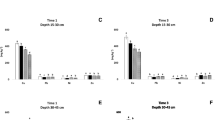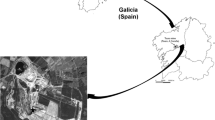Abstract
Mine soils often contain high levels of metals that produce serious environmental problems and poor fertility conditions that limit their reclamation. The aim of this study was to evaluate the influence of a compost and biochar amendment on the nutrient phytoavailability in a mine soil from the depleted copper mine of Touro (Spain). For this purpose, a greenhouse experiment was carried out amending the mine soil with increasing proportions (20, 40, 80 and 100%) of the compost and biochar mixture and planting Brassica juncea plants. The results revealed that the mine soil had an extremely acid pH and low fertility conditions and was affected by copper contamination. The addition of compost and biochar to the mine soil increased soil pH values (from 2.7 to 8.7), total carbon (from undetectable values to 149 g kg−1) and total nitrogen (from undetectable values to 11,130 mg kg−1) contents and phytoavailable concentrations of K, Mg, Na and P and promoted plant growth, since B. juncea plants did not survive in the untreated mine soil. The application of amendment decreased the phytoavailable concentration of Al, Co, Cu, Fe and Ni in the soil, resulting in a reduction of copper toxicity. The use of compost and biochar as a soil amendment combined with B. juncea plants could be an efficient strategy for the reclamation of degraded soils with low fertility conditions.




Similar content being viewed by others
References
Abujabhah, I. S., Bound, S. A., Doyle, R., & Bowman, J. P. (2016). Effects of biochar and compost amendments on soil physico-chemical properties and the total community within a temperate agricultural soil. Applied Soil Ecology, 98, 243–253.
Agegnehu, G., Bass, A. M., Nelson, P. N., Muirhead, B., Wright, G., & Bird, M. I. (2015). Biochar and biochar-compost as soil amendments: effects on peanut yield, soil properties and greenhouse gas emissions in tropical North Queensland, Australia. Agriculture, Ecosystems and Environment, 213, 72–85.
Alvarenga, P., Gonçalves, A. P., Fernandes, R. M., Varennes, A., Vallini, G., Duarte, E., & Cunha-Queda, A. C. (2008). Evaluation of composts and liming materials in the phytostabilization of a mine soil using perennial ryegrass. Science of the Total Environment, 406, 43–56.
Babu, D. N., Prasadini, P. P., Ramesh, T., & Prasad, J. V. N. S. (2014). Effective microbial compost—an alternative nitrogen source to crops under climate change scenario. Ecology, Environment and Conservation, 20, S435–S438.
Baldantoni, D., De Nicola, F., & Alfani, A. (2010). Can compost applications affect metal and PAH contents in Mediterranean agricultural soils? Fresenius Environmental Bulletin, 19, 1735–1740.
Beesley, L., Moreno-Jiménez, E., Gomez-Eyles, J. L., Harris, E., Robinson, B., & Sizmur, T. (2011). A review of biochars’ potential role in the remediation, revegetation and restoration of contaminated soils. Environmental Pollution, 159, 3269–3282.
Bolan, N., Adriano, D., & Mahimairaja, S. (2004). Distribution and bioavailability of trace elements in livestock and poultry manure by-products. Critical Reviews in Environmental Science and Technology, 34, 291–338.
Bougnom, B. P., Mair, J., Etoa, F. X., & Insam, H. (2009). Composts with wood ash addition: a risk or a chance for ameliorating acid tropical soils? Geoderma, 153, 402–407.
Dickinson, N.M., (2000). Strategies for sustainable woodland on contaminated soils. Chemosphere, 41, 259e263.
Elmaslar Özbaş, E. (2015). The use of municipal solid waste compost in contaminated soil to reduce the availability of Ni and Cd: a study from Istanbul. Environmental Progress and Sustainable Energy, 34, 1372–1378.
Fowles, M. (2007). Black carbon sequestration as an alternative to bioenergy. Biomass and Bioenergy, 31, 426–432.
Fu, X., Shao, M., Wei, X., & Horton, R. (2010). Soil organic carbon and total nitrogen as affected by vegetation types in Northern Loess Plateau of China. Geoderma, 155, 31–35.
Gajalakshmi, S., & Abbasi, S. A. (2008). Solid waste management by composting: state of the art. Critical Reviews in Environmental Science and Technology, 38, 311–400.
Gall, J. E., & Rajakaruna, N. (2013). The physiology, functional genomics, and applied ecology of heavy metal-tolerant Brassicaceae. In M. Lang (Ed.), Brassicaceae: characterization, functional genomics and health benefits (pp. 121–148). New York: Nova.
Garbisu, G., & Alkorta, I. (2001). Phytoextraction: a cost-effective plant-based technology for the removal of metals from the environment. Bioresource Technology, 77, 229–236.
González-Ubierna, S., Jorge-Mardomingo, I., Carrero-González, B., de la Cruz, M. T., & Casermeiro, M. Á. (2012). Soil organic matter evolution after the application of high doses of organic amendments in a Mediterranean calcareous soil. Journal of Soils and Sediments, 12, 1257–1268.
Houba, V. J. G., Temminghoff, E. J. M., Gaikhorst, G. A., & Van Vark, W. (2000). Soil analysis procedures using 0.01 M calcium chloride as extraction reagent. Communications in Soil Science and Plant Analysis, 31, 1299–1396.
Iovieno, P., Baldantoni, D., De Nicola, F., Alfani, A., Morra, L., & Zaccardelli, M. (2006). Multidisciplinary approach to validate compost use in vegetable crop systems of Campania region (Italy): influence of compost rates on soil biological activity and heavy metal content. Acta Horticulturae, 700, 272–274.
Kabata-Pendias, A. (2011). Trace elements in soils and plants (4th ed.). Boca Raton: CRC.
Karami, N., Clemente, R., Moreno-Jiménez, E., Lepp, N. W., & Beesley, L. (2011). Efficiency of green waste compost and biochar soil amendments for reducing lead and copper mobility and uptake to ryegrass. Journal of Hazardous Materials, 191, 41–48.
Karer, J., Wawra, A., Zehetner, F., Dunst, G., Wagner, M., Pavel, P.-B., Puschenreiter, M., Friesl-Hanl, W., & Soja, G. (2015). Effects of biochars and compost mixtures and inorganic additives on immobilisation of heavy metals in contaminated soils. Water, Air, & Soil Pollution, 226, 342.
Kargar, M., Clark, O. G., Hendershot, W. H., Jutras, P., & Prasher, S. O. (2015). Immobilization of trace metals in contaminated urban soil amended with compost and biochar. Water, Air, & Soil Pollution, 226, 191.
Kohler, J., Caravaca, F., Azcón, R., Díaz, G., & Roldán, A. (2014). Selection of plant species–organic amendment combinations to assure plant establishment and soil microbial function recovery in the phytostabilization of a metal-contaminated soil. Water, Air, & Soil Pollution, 225, 1930.
Lannan, A. P., Erich, M. S., & Ohno, T. (2013). Compost feedstock and maturity level affect soil response to amendment. Biology and Fertility of Soils, 49, 273–285.
Liu, J., Schulz, H., Brandl, S., Miehtke, H., Huwe, B., & Glaser, B. (2012). Short-term effect of biochar and compost on soil fertility and water status of a Dystric Cambisol in NE Germany under field conditions. Journal of Plant Nutrition and Soil Science, 175, 698–707.
Liu, J.-B., Zhang, Y.-Q., Wu, B., Qin, S.-G., Jia, X., Fa, K.-Y., Feng, W., & Lai, Z.-R. (2015). Effect of vegetation rehabilitation on soil carbon and its fractions in Mu Us Desert, Northwest China. International Journal of Phytoremediation, 17, 529–537.
Macías, F., & Calvo de Anta, R. (2009). Niveles genéricos de referencia de metales pesados y otros elementos traza en los suelos de Galicia. Spain: Xunta de Galicia.
Madejón, P., Alaejos, J., García-Álbala, J., Fernández, M., & Madejón, E. (2016). Three-year study of fast-growing trees in degraded soils amended with composts: effects on soil fertility and productivity. Journal of Environmental Management, 169, 18–26.
Manzano, R., Peñalosa, J. M., & Esteban, E. (2014). Amendment application in a multicontaminated mine soil: effects on trace element mobility. Water, Air, & Soil Pollution, 225, 1874.
Marx, E.S., Hart, T., & Stevens, R.G. (1999). Soil test interpretation guide (p. 7). Oregon, USA.
Montiel-Rozas, M. M., Madejón, E., & Madejón, P. (2015). Evaluation of phytostabilizer ability of three ruderal plants in mining soils restored by application of organic amendments. Ecological Engineering, 83, 431–436.
Mourato, M. P., Moreira, I. N., Leitão, I., Pinto, F. R., Sales, J. R., & Martins, L. L. (2015). Effect of heavy metals in plants of the genus Brassica. International Journal of Molecular Sciences, 16, 17975–17998.
Pérez-De-Mora, A., Madejón, P., Burgos, P., Cabrera, F., Lepp, N. W., & Madejón, E. (2011). Phytostabilization of semiarid soils residually contaminated with trace elements using by-products: sustainability and risks. Environmental Pollution, 159, 3018–3027.
Porta, J., López-Acevedo, M., & Rodríguez, R. (1986). Técnicas y experimentos en Edafología. Barcelona: Collegi Oficial D’Enginyers Agrònoms de Catalunya.
Puig, C. G., Álvarez-Iglesias, L., Reigosa, M. J., & Pedrol, N. (2013). Eucalyptus globulus leaves incorporated as green manure for weed control in maize. Weed Science, 61, 154–161.
Rodríguez-Vila, A., Asensio, V., Forján, R., & Covelo, E. F. (2015). Chemical fractionation of Cu, Ni, Pb and Zn in a mine soil amended with compost and biochar and vegetated with Brassica juncea L. Journal of Geochemical Exploration, 158, 74–81.
Shaheen, S. M., Tsadilas, C. D., & Rinklebe, J. (2013). A review of the distribution coefficient of trace elements in soils: influence of sorption system, element characteristics, and soil colloidal properties. Advances in Colloid and Interface Science, 201–202, 43–56.
Soumaré, M., Tack, F. M. G., & Verloo, M. G. (2007). Redistribution and availability of iron, manganese, zinc, and copper in four Malian agricultural soils amended with solid municipal waste compost. Communications in Soil Science and Plant Analysis, 38, 2567–2579.
Stevenson, F. J., & Ardakani, M. S. (1972). Organic matter reactions involving micronutrients in soils. In J. J. Mortvedt, P. M. Giordano, & W. L. Lindsay (Eds.), Micronutrients in agriculture (pp. 79–114). Madison: Soil Science Society of America.
Tang, X., Liu, S., Liu, J., & Zhou, G. (2010). Effects of vegetation restoration and slope positions on soil aggregation and soil carbon accumulation on heavily eroded tropical land of Southern China. Journal of Soils and Sediments, 10, 505–513.
USDA, (1998). Soil quality indicators: pH.
Van Ginneken, L., Meers, E., Guisson, R., Ruttens, A., Elst, K., Tack, F. M. G., Vangronsveld, J., Diels, L., & Dejonghe, W. (2007). Phytoremediation for heavy metal-contaminated soils combined with bioenergy production. Journal of Environmental Engineering and Landscape Management, 15, 227–236.
Wang, L., Sun, X., Li, S., Zhang, T., Zhang, W., & Zhai, P. (2014). Application of organic amendments to a coastal saline soil in north China: effects on soil physical and chemical properties and tree growth. PLoS ONE, 9, e89185.
Wong, J. W. C., & Selvam, A. (2009). Growth and elemental accumulation of plants grown in acidic soil amended with coal fly ash-sewage sludge co-compost. Archives of Environmental Contamination and Toxicology, 57, 515–523.
Acknowledgments
The authors would like to thank the anonymous reviewers for their comments, which helped to improve the quality of this article.
Author information
Authors and Affiliations
Corresponding author
Ethics declarations
The present research did not involve any human participants and/or animals.
Conflict of Interest
The authors declare that they have no conflicts of interest.
Rights and permissions
About this article
Cite this article
Rodríguez-Vila, A., Forján, R., Guedes, R.S. et al. Changes on the Phytoavailability of Nutrients in a Mine Soil Reclaimed with Compost and Biochar. Water Air Soil Pollut 227, 453 (2016). https://doi.org/10.1007/s11270-016-3155-x
Received:
Accepted:
Published:
DOI: https://doi.org/10.1007/s11270-016-3155-x




